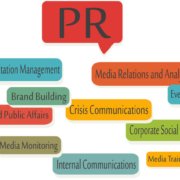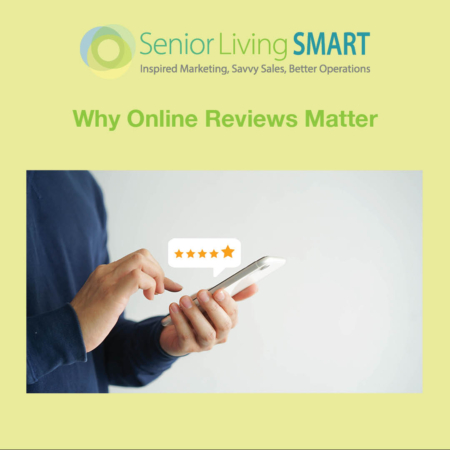Senior Living Reputation Management: 7 Tips
Reviews matter. Full stop. People rarely make purchases without checking reviews on places like Amazon and Yelp, Google and Facebook—to all the many sites in between.
According to Qualtrics, 97% of all consumers use online media when researching products or services in their local area. And 93% of consumers say online reviews influence their purchasing decision.
Bottom line: Senior living reputation management is extremely important and should be a regular part of your ongoing marketing and sales tasks. Need some tips? Keep reading.
1. Claim and maintain listings on popular review sites.
The first step to effective senior living reputation management is to claim listings where people leave reviews. Focus on review sites that rank high in organic search, starting with your Google My Business listing (as well as Yahoo! and Bing Places for Business).
From there, focus on highly-trafficked review sites related to the senior living industry, such as Caring.com and SeniorAdvisor.com. (The latter has a turnkey approach to claiming your listing, responding to reviews, and soliciting more reviews.)
An important reminder: Whether you’re actively managing your listings or not, the listings most likely already exist. So even if you haven’t claimed your business listing on Caring.com, your senior living community is probably already listed and getting reviews.
Claiming a profile simply allows you to manage reviews better (as well as other information, such as phone numbers). Plus, you can respond to reviews (good and bad) as the business.
2. Actively monitor reviews and act on suggestions.
Pay attention to suggestions and criticisms brought up in reviews. If you keep hearing people talk about the same positive things, make sure you’re promoting these items throughout other marketing materials, like your senior living website, lead nurturing, and social media.
On the flip side, if you see a recurring theme in people’s grievances, do something about those complaints. Once you’ve made changes or addressed the complaints, pay close attention to reviews moving forward. Hopefully, you’ll see fewer rumblings about the issue.
3. Respond thoughtfully to reviews.
Let’s break it down into positive reviews, meh reviews (average, three stars), poor reviews, and abusive/trolling reviews.
- Positive reviews. Acknowledging positive reviews is a nice way to say thanks to reviewers and to show other people that you’re actively monitoring and responding to consumers.
- Meh/average reviews. While the goal is to gather positive reviews, the reality is average and negative reviews are a part of doing business. In fact, some savvy consumers might be suspicious if a business has only glowing reviews. Two- and three-star reviews usually involve the reviewer pointing out positives and negatives. If you respond, the key is to thank the person for their honest feedback. Let them know you’re glad they’re happy with X (positive stuff). And thank them for bringing your attention to Y (negative stuff).
- Poor reviews. In those truly negative one- and two-star reviews, people are clearly unhappy and they’re publicly calling out your community. Acknowledge their complaints. Thank them for their honest feedback, even though it’s tough to hear. Ask them if they’d be open to communicating offline so you can learn more about the issue. Let them know that you and your team members are listening and always striving to do better. This is where senior living reputation management can be difficult but is essential.
- Abusive/trolling reviews. The customer isn’t always right. You do not need to tolerate reviews that contain toxic, offensive, or bullying language. Do not respond to the reviewer directly. Follow the platform’s internal protocols for flagging and disputing a review. Some sites will remove these sorts of reviews after an internal evaluation. But even if the site doesn’t remove the review, don’t fret. Today’s consumers are savvy. They can discern between someone who is leaving a legit review about a mediocre experience or a troll who is directing hatred at your community.
4. Don’t forget to monitor social media.
People often air their grievances on places like Facebook, Twitter, and Instagram. Don’t overlook mentions of your community, especially those that are negative. It doesn’t take much for a negative tweet or Facebook post to go viral.
Remember, be thoughtful in how you respond on social media. Empty sounding phrases or condescending-sounding responses (e.g., “We’re sorry you feel that way”) provide little value and come off sounding defensive or aloof. Sound human. “We’re so sorry about your experience and we want to know more so we can address it. Please DM us or call this number directly and ask for Susan.”
5. Have a clear review solicitation strategy.
The best antidote to bad reviews? More good reviews. As we mentioned earlier, soliciting reviews should be an ongoing task.
In correspondence with residents/families, always remind people that you welcome reviews. In electronic communications, you can include a direct link to the place where you want people to leave a review.
For example, you might write: “Do you love living in The Elmwood Senior Living? Tell people about it! Provide a review about your experience.” You can swap out where you link to over time. Perhaps one quarter, you focus on your Google listing. Another quarter, you focus on SeniorAdvisor.com. And so forth.
6. Promote and repurpose reviews.
The words of other people provide that all-important “social proof” that consumers care about. Promote your positive reviews throughout your marketing materials.
- Add a plug-in to your website’s home page that highlights the latest five-star reviews.
- Sprinkle positive reviews on other high-traffic website pages, such as locations, amenities, and contact.
- Share reviews on social media. “Another happy resident talks about her experience at The Elmwood . . .”
- Use stellar reviews in print collateral, such as brochures and print ads.
7. Work with a partner to help handle your senior living reputation management.
Monitoring and managing reviews (not to mention regularly asking for reviews) can be a lot of work. Turn to a trusted partner like Senior Living SMART to manage this task for you. We know senior living inside and out, including the review sites you need to pay attention to. Let’s talk about your community’s specific needs.





